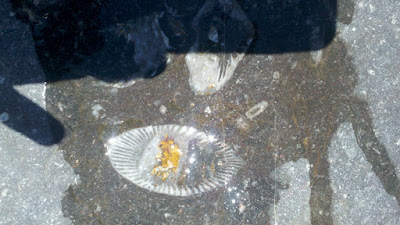Great Mullein
Its a really tall plant with yellow flowers that look like a sword.
We did a spot of fishing hoping to catch one of the many fish on the list.......
Fishing
We didn't manage to catch anything. But i did get attacked by some barnacles which scraped my ankle......
Ouch!!
But it was OK because they were on the list....
Barnacles
We also spotted lots of Limpets.....
Limpet
Then my Dad showed me something i didn't expect to see in Wales, a coral reef.
Along long time ago the bit of land that is Wales used to be in the tropic zone. The surface of the world is covered with plates that float on top of the lava in the middle. These plates slowly move around so that our bit of land used to be where Africa is today. Back then South Wales was a shallow tropical sea full of corals. Over time bits of sediment and dirt fell on top of the corals and over the years the sediment turned into rock and turned the corals into fossils. More recently the sea has worn the rock away and you can now see fossilised corals on the beaches of the Heritage Coast if you want to know more, have a look at this (http://education.gtj.org.uk/en/item1/26445). The ones in my pictures are Caninia. A cool trick to see the fossils better is to rub some water on the stone, this darkens the stone and lightens the fossil so you can see it better.....
Caninia
Caninia
We finished off the week camping at the Heritage Coast camp site (http://perfectpitchcamping.co.uk/). It was really good fun, we watched the sun set and roasted marshmallows on the campfire. A Little Owl woke us up in the night screeching but i had my best nights sleep in the wild ever, the owners are really nice and will even cook you breakfast and bring it to your tent in the morning.....
Heritage Coast Campsite
Our camp
Sunset
Sunset
Nice and warm by the campfire
Roasting Marshmallows
Thats 3 off the list....
Limpet (Patella vulgata)
These are little things that live in a shell on rocks, they feed by grazing on algae growing on the rocks. When the tide comes in they move around over the rocks feeding. Each limpet has a home which is a small dip on the rock and the limpet always returns to this spot when its finished feeding.
Barnacle (Balanidae)
These little creatures feed on plankton and attached themselves to rocks in the intertidal zone (the area between low and high tide). They have a hard sharp shell which is what cut my ankle.
Great Mullein (Verbascum thapsus)
This is the biggest Mullein, that's why its called Great Mullein. The leaves of this plant look really soft because they are covered in tiny hairs. These hairs catch fire really easily and used to be used to make 'wicks' for lamps in the old days.













Good luck with your challenge Rudi. It looks as though you have made a good start.
ReplyDeleteThanks for the comment
Delete